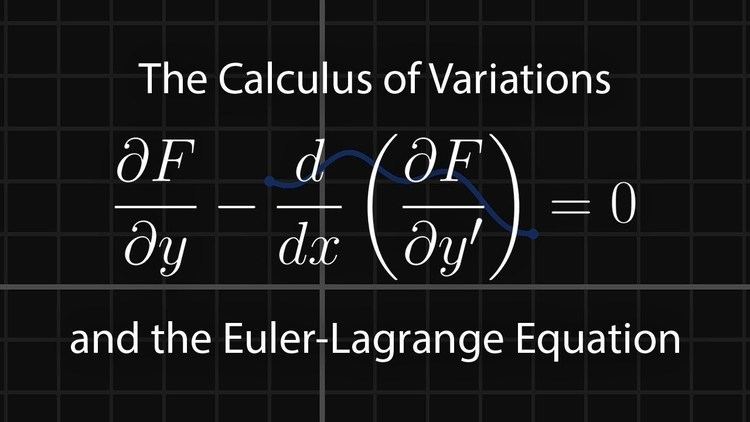Similar Lane–Emden equation, Exact differential equation, Matrix differential equation | ||

In the calculus of variations, the Euler–Lagrange equation, Euler's equation, or Lagrange's equation (although the latter name is ambiguous—see disambiguation page), is a second-order partial differential equation whose solutions are the functions for which a given functional is stationary. It was developed by Swiss mathematician Leonhard Euler and Italian-French mathematician Joseph-Louis Lagrange in the 1750s.
Contents
- History
- Statement
- Examples
- Single function of single variable with higher derivatives
- Several functions of single variable with single derivative
- Single function of several variables with single derivative
- Several functions of several variables with single derivative
- Single function of two variables with higher derivatives
- Several functions of several variables with higher derivatives
- Generalization to Manifolds
- References
Because a differentiable functional is stationary at its local maxima and minima, the Euler–Lagrange equation is useful for solving optimization problems in which, given some functional, one seeks the function minimizing (or maximizing) it. This is analogous to Fermat's theorem in calculus, stating that at any point where a differentiable function attains a local extremum, its derivative is zero.
In Lagrangian mechanics, because of Hamilton's principle of stationary action, the evolution of a physical system is described by the solutions to the Euler–Lagrange equation for the action of the system. In classical mechanics, it is equivalent to Newton's laws of motion, but it has the advantage that it takes the same form in any system of generalized coordinates, and it is better suited to generalizations. In classical field theory there is an analogous equation to calculate the dynamics of a field.
History
The Euler–Lagrange equation was developed in the 1750s by Euler and Lagrange in connection with their studies of the tautochrone problem. This is the problem of determining a curve on which a weighted particle will fall to a fixed point in a fixed amount of time, independent of the starting point.
Lagrange solved this problem in 1755 and sent the solution to Euler. Both further developed Lagrange's method and applied it to mechanics, which led to the formulation of Lagrangian mechanics. Their correspondence ultimately led to the calculus of variations, a term coined by Euler himself in 1766.
Statement
The Euler–Lagrange equation is an equation satisfied by a function q of a real argument t, which is a stationary point of the functional
where:
The Euler–Lagrange equation, then, is given by
where Lx and Lv denote the partial derivatives of L with respect to the second and third arguments, respectively.
If the dimension of the space X is greater than 1, this is a system of differential equations, one for each component:
Examples
A standard example is finding the real-valued function f on the interval [a, b], such that f(a) = c and f(b) = d, for which the path length along the curve traced by f is as short as possible.
the integrand function being L(x, y, y′) = √1 + y′ ² evaluated at (x, y, y′) = (x, f(x), f′(x)).
The partial derivatives of L are:
By substituting these into the Euler–Lagrange equation, we obtain
that is, the function must have constant first derivative, and thus its graph is a straight line.
Single function of single variable with higher derivatives
The stationary values of the functional
can be obtained from the Euler–Lagrange equation
under fixed boundary conditions for the function itself as well as for the first
Several functions of single variable with single derivative
If the problem involves finding several functions (
then the corresponding Euler–Lagrange equations are
Single function of several variables with single derivative
A multi-dimensional generalization comes from considering a function on n variables. If Ω is some surface, then
is extremized only if f satisfies the partial differential equation
When n = 2 and
Several functions of several variables with single derivative
If there are several unknown functions to be determined and several variables such that
the system of Euler–Lagrange equations is
Single function of two variables with higher derivatives
If there is a single unknown function f to be determined that is dependent on two variables x1 and x2 and if the functional depends on higher derivatives of f up to n-th order such that
then the Euler–Lagrange equation is
which can be represented shortly as:
wherein
Several functions of several variables with higher derivatives
If there are p unknown functions fi to be determined that are dependent on m variables x1 ... xm and if the functional depends on higher derivatives of the fi up to n-th order such that
where
where the summation over the
Generalization to Manifolds
Let
where
